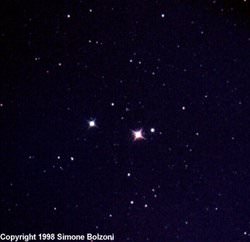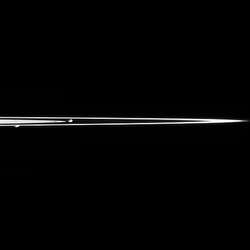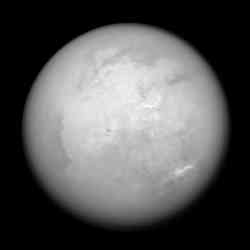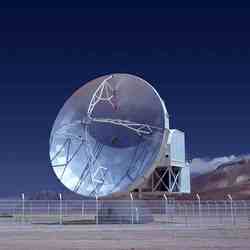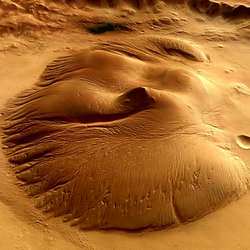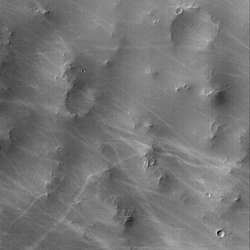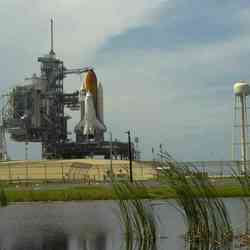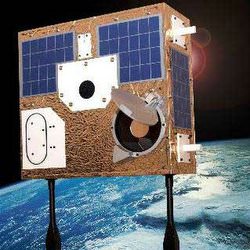
Artist illustration of Canada’s Most Telescope. Image credit: MOST. Click to enlarge.
Canada’s first space telescope, MOST, looks for minute variations in the brightness of nearby stars. As Jaymie Matthews, of the University of British Columbia, explains in this talk given at a recent symposium on extrasolar planets, MOST can provide scientists with a unique perspective on how distant worlds interact with their host stars.
I’d like to describe a powerful new small instrument in space called MOST, which stands for Microvariability and Oscillations of Stars (and because it’s Canadian, it stands for Microvariabilit? et Oscillations Stellaire as well). MOST is Canada’s first space telescope. It is literally a suitcase in space: 60 by 60 by 30 centimeters (24 by 24 by 12 inches), 54 kilos, about 124 pounds. I weigh more than the MOST satellite; I think I’m the only mission scientists that out-masses his space satellite. And you can check it on the plane; they can lose it for you.
MOST was actually designed to do seismology of stars, to probe the interiors and histories of stars. That’s relevant to the exoplanets search, because the more we know about parent stars, the more we know about their planetary systems. But we realized, once MOST was underway, that we could actually do some additional exciting things in the exoplanet field. One of the things that MOST can do that nobody else can do at the moment is to stare at stars for up to 2 months at a time, putting stars on a stakeout, to detect variations in the brightnesses of stars or the brightnesses of the planets orbiting those stars, down to a level of 1 part per million, 1 ten-thousandth of a percent.
Just to emphasize to you how small that is, if you were to go to New York City and look at the Empire State Building at night, all the lights were on, all the office window blinds were open and you wanted to make the Empire State Building darker by 1 part per million, you would lower one shade by 3 centimeters, by a little more than an inch. That’s the level of signal that we are looking for in stars. And there is no other instrument on Earth or in space right now that’s capable of doing this. And I should point out that this whole mission has an end-to-end budget of $10 million Canadian, or $7 million US. So we’re the Wal-Mart of space telescopes.
MOST has a unique vantage point in space. It has a very different orbit from the Hubble Space Telescope, or from Spitzer, a pole-to-pole orbit. We communicate with it with our own little custom ground-station network in Toronto, Vancouver and Vienna, and we got into that orbit on the top of a former Soviet Intercontinental Ballistic Missile. A honest-to-goodness weapon of mass destruction. So not only did we put up a scientific instrument, but we destroyed a weapon of mass destruction in the bargain. MOST launched from northern Russia on June 30, 2003, so we’re approaching our second anniversary in space.
Being able to give a star that kind of intense long-term coverage is really important for astronomers to understand what’s going on in systems that have exoplanets. To give an analogy, we’re trying to read the messages that stars and exoplanets are telling us, but from the ground, we only get part of that message. If you have a network of telescopes on the ground, spread in a longitude, you can start to fill in some of the gaps, you can start to recognize some things that look like words. If you have some theories and expectations ahead of time, you might be able to infer a bit of the story, but you could very well get the completely wrong story if you’ve made the wrong assumptions. Having this kind of continuous coverage of a star allows us to really see what stars are doing, and in the case of exoplanets systems, what the exoplanets around them are doing.
MOST is primarily intended to study very tiny variations in stars’ output light. We’re trying to put our own Sun in context by looking at other sunlike stars, looking at some of the senior citizens our galactic city, trying to put some limits on the age of the universe. But the point that’s most important for us today is the fact that MOST also does exoplanet science. What we are looking for is reflected light, the same kind of wavelengths that you see with your eye, from close-in giant planets that have become known as hot Jupiters.
We’re not an exoplanets hunter. We’re too small a telescope to have a statistical chance of finding new planets. We would have to be very lucky. But we are an exoplanet explorer. We take advantage of the work of Drs. Mayor and Brown, and Geoff Marcy, and other groups, who find the planets with their Doppler surveys, and then we can go in and take a closer look. We’ve examined 3 known exoplanet systems already, Tau Bootis, HD 209458 – the telephone-book numbers that astronomers love for stars – and 51 Pegasi, the very first exoplanet around a normal star, which Dr. Mayor and his colleague, Didier Queloz, discovered 10 years ago.
When we looked at Tau Bootis, in a trial run last year, for 11 days, continuously, we saw a signal that very closely matched the planet’s orbital period. But it was far too large to be associated with the planet. It’s about .25 percent, and this is almost certainly originating in the star itself. Tau Bootis, the star, is far more active and variable than we imagined. And we’ve now been able to combine the Doppler data with the data from MOST and the light cures line up, beautifully. The star’s brightness is varying with exactly the same period as the planet orbiting around it.
We’re accustomed to bodies tidally locking each other through their gravitational influence if they’re close enough. The Earth has locked the Moon into a rotation period related to its orbit, so the Moon always keeps the same face to us. We’re convinced that these exoplanets close to their parent stars are tidally locked, so that they always keep one face to the star. But it’s almost counter-intuitive, like the tail wagging the dog, that a planet should be able to tidally lock the star. Now, in this case, it’s probably not locking the entire star, but rather its outer envelope, but there may be a kind of a spot complex, like a super-sunspot, on the surface of Tau Bootis, which has been somehow triggered by the influence of the planet, Tau Bootis b, and tracks it in its orbit. This was suspected by some of the ground-based data, but MOST has been able to confirm that these things are in perfect lockstep.
The good news is that we’re learning a lot about the star that we didn’t know before, and maybe about the interactions between the planet and the star. Possibly their magnetic fields are interacting. Usually rapidly rotating stars are young, but we don’t really know anything about the age of Tau Bootis other than information based on its rotation rate and its activity. It’s hard for us to tell: Is it genuinely young, or maybe it’s an older star, and when the planet migrated in the star was spun up and rejuvenated, kind of going through a second childhood. The bad news is that this stellar activity is going to make it hard to see reflected light from the planet, although we’re not going to give up on that, and we’re going to continue to observe Tau Bootis.
Original Source: NASA Astrobiology

